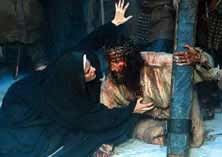The Passion of the Christ (2004)
 |
THE PASSION OF THE CHRIST
Review by Gnoll |
Okay, first things first. I did see Mel Gibson’s THE PASSION OF THE CHRIST several weeks ago, when it was still fairly new to the theater. I held off on reviewing the film for a variety of reasons, but it kinda pained me at the time, because I had a helluva lot to say about it. I guess I held off because I wasn’t exactly how the film would gel on a forum that spends much of its time talking about nostalgic cartoon shows, zombie movies, and bootleg toys from Southeast Asia. Or perhaps I thought the subject matter was a little too touchy for particular readers. But whatever it was, I’m over it now, and you’re getting a PASSION review now. Enjoy.

I realize that this film is different from most of the other fare out there. When you go see this movie, it’s a different experience than going to see STARSKY AND HUTCH or JERSEY GIRL. This ain’t Friday-date-night popcorn flick fare. It’s pretty heavy subject matter, and it’s controversally violent material.THE PASSION stirred up a lot of controversy right out of the gate, because, well, it’s about Jesus. And as I have been taught throughout my life with the aid of Madonna videos, you’re always going to cause a stir when you add Christ to the picture.
I’m sure a lot of reviewers on my level would come out and make a joke about how they liked the book better, but I’m not going to do it. I’m just going to make a joke about how I’m above that as a not-so-clever way to work the joke in to begin with.
I’ll also get the personals out of the way: I went in to this film not for some religious experience, nor did I I want to jump on the critical bandwagon. I went in because I like good movies, and that’s what I expected THE PASSION to be. Fuck all of the Christian zealots who want to use this film as a recruitment video, fuck the critical mass who think that this movie was designed as an ode to anti-semitism, and fuck Mel Gibson’s kooky senile father. I’m a movie watcher. I like movies. Subject matter is only a peripheral reason to see something like this.

By that token, as someone who has never exactly been a regular churchgoer, I’m going in expecting the film to tell me a story that I don’t need four years of bible college to comprehend. Oh the flipside, though, I’m not looking for a four-hour epic giving me the background on every single character. All I’m looking for is a great motion picture that tells a great story, with no regard to the super-sensitive religious subject matter.
In that respect, THE PASSION OF THE CHRIST is a great movie. Skillfully directed, beautifully shot, and well-acted. Mel Gibson set out to make a powerful film displaying the suffering of the principal player of his religion, and he succeeded. Unfortunately, this film won’t be judged on those merits by the majority of critics out there. They’ll go in with a bias in regard to the subject matter, either automatically loving it because of their faith or lambasting it because of the alleged antisemitism, graphic violence, or conflicting religious beliefs. But this reviewer went in with none of those preconceptions, and enjoyed the film as a film.
THE PASSION, of course, follows the events of the last 24 hours of the life of Jesus Christ, as told by the New Testament. As a result, it’s bleak, dark, and graphic. The idea that Gibson is presenting is that this is the suffering that Christ endured for his convictions. And suffer he does. Yeah, this is probably the most violent film I’ve ever had to bear witness to. But it has to be, in order to drive home the filmmaker’s message. For the first time since I entered puberty, I actually had to avert my eyes at some of the violence in a film. It’s gruesome, to say the least, but it’s all part of what makes the film so powerful.

As the film takes place within the course of a few hours, much of the events leading up to the crucifixion are told in a series of flashbacks. These serve to introduce the characters of Christ, Mary, Mary Magdalene, Judas, and others to the viewer who might not be as familiar with the story. Some of these flashbacks portray events of suffering, while some of them even inject a bit of humor into the film. The idea is even presented that Christ invented the modern table, but it’s done in a relatively lighthearted scene and likely not intended to reflect historical accuracy.
The charges that the film is antisemitic have been at the top of the mountain of controversy surrounding the film. And while I’m not one to quibble with just how much historical accuracy went into the story, the film only resurrects the actual historical events of the time as they have been widely reported for two milennia. That said, I was a bit disappointed in the way that Pontias Pilate was portrayed. As someone who, as I mentioned before, has never been a devout Christian, I can’t say that I’m an expert on the subject, but from all that I’ve surmised over the years is that Pilate was a pretty reprehensible guy. In this film, though, he’s portrayed completely as a sympathetic character. For the context, I can understand a bit of that, since he was told to have lamented his decision to execute Christ, but this film almost portrays him as angelic.
Jim Caveziel gives an amazing performance as Jesus Christ, putting his own religious conviction into the role. Of course, this has also been a point of controversy, since the actor is a white man, but Christ is obviously not intended to be portrayed as a blond-haired-blue-eyed Aryan poster boy here. If anything, he (and the majority of the other actors involved) were designed to appear as Christ was — middle eastern. Every other actor involved does their job well, reflecting the emotion and (dare I say it) the passion of the subject matter. Of course, I’d heard a lot of good things about Monica Belucci going in to the film, but it’s not like she had to do anything but stand around and cry.

The film, of course, is presented in Aramaic, Hebrew, and Latin, with subtitles. While this might scare away some viewers, it hasn’t seemed to hurt the film’s box office statistics, as it has grossed almost half a billion dollars as of this writing, and the Easter weekend is bound to give it a surge as well. However, as Chad mentioned in his review of ATTACK OF THE CLONES, one sign of a good movie is the ability to turn the sound off and follow the action. This film definitely fits that bill. The dialogue is secondary to the visuals, and the visuals get by just fine on their own. There’s also been a bit of controversy over whether or not the Romans spoke Latin or Greek at this time, but that’s people just arguing for the sake of arguing.
Kudos to Mel Gibson for making this film. This is filmmaking. Gibson financed this film completely on his own, produced it without ever knowing if anyone would distribute it, and as a testament for his effort has been labeled a zealot and an antisemite (as well as being blacklisted by one of the most powerful studios in Hollywood, Dreamworks.) But Gibson made this film because he had a vision, and not because he wanted a payday. He risked everything that he had worked for for decades in order to have this film see print. And in the process, he made a film that will, like it or not, be a classic for many years to come.
If antyhing, THE PASSION blows away the traditional stereotype of the biblical epic. Gone are the grandiose chest-beating scenes that occupied THE BIBLE and BEN-HUR. Gone is the “Americanized” (or “Europeanized”, if you will) adaptation of films like THE LAST TEMPTATION OF CHRIST. This film is an altogether new experience in the genre, and one that’s likely to stick in the craw.

The film’s biggest flaw, though, is in its final moment. No, I’m not going to spoil anything by giving it away (I mean, I am going to give it away, but you can kind of see it coming) but it’s something that bothered me. The film is called THE PASSION OF THE CHRIST for a reason. It is designed to show the suffering of the man. As the film concludes, the crucifixion is completed, and Christ dies on the cross. He is removed, and his lifeless body lies in his mother’s arms. It’s a powerful image that truly sums up the pain in the film. The film then fades to black. There is no more perfect way to end this film, right? Well, someone thought otherwise here. Before the credits roll, we are presented the risen Christ, shown in his angelic white robes and complete with halo and stigmata. It’s a vision of hope and positivity…but it doesn’t fit in this film. I’m not sure if this final sequence was the original vision of Gibson, or if it was the result of test-marketing, but it really goes against everything we have just endured. Besides the uppity “Hollywood Ending” it seems to give the film, the other-worldly aspect of it just feels tacked on. For the rest of the film, anything perceived as supernatural was played almost as if it were a hallucination. Judas is tormented by demons, Satan is envisioned by Christ in the crowds, but it’s all played in a subdued, historical light rather than a fantastic one. The resurrection scene just stuck out like a sore…palm.
As I said while walking out of the theater, “they should have saved it for the sequel.”
Want a second opinion of this film? Take a look at Ron Hogan’s review over at Living Corpse dot com!

 subscribe to rss
subscribe to rss 

























Leave your response!